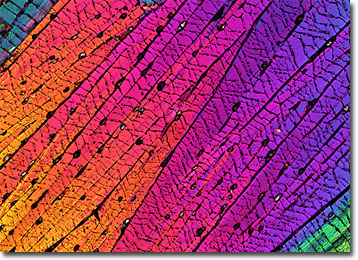Polarized Light Microscopy Digital Image Gallery
Rhodamine
A rhodamine is any of a group of orange, red, and pink dyes that are utilized for a variety of purposes. Synthesized in the laboratory, rhodamines are produced from phthalic anhydride and aminophenols.

View a second image of Rhodamine
Many rhodamines are fluorescent and are heavily utilized as fluorochromes in the field of microscopy. The dyes are especially well suited for labeling proteins and membranes, but can be used for other applications as well. Some rhodamines, for instance, such as lissamine rhodamine, gain wide use in flow tracing studies, while others, like tetramethyl rhodamine, are more popular in energy transfer research. Also, rhodamine 6G, which produces an orange-yellow light, can be utilized as a dye laser.
In addition to scientific applications, rhodamines are often useful in ways that make them more familiar to a broader public. For example, some varieties of rhodamine are utilized in the textile industry and may be responsible for the pinkish hue of a silk shirt or the red coloring of a wool coat. Rhodamines are also often added to outdoor paints used for billboards and other forms of advertising. The strong fluorescing of the molecules in the dyes makes the signs easier to see, especially at night. Rhodamines do, however, exhibit a relatively poor stability in light, although the dyes are significantly more photostable than fluorescein dyes.
